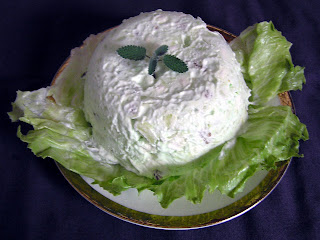
Holiday Meatloaf
Dorcas Annette Walker
Meat is considered to be the main dish of a meal as it contains the most complete source of protein along with other vitamins and minerals. Often the highest portion of grocery money is spent on meat. Using hamburger to make meatloaf is one of the diversified ways of using ground beef. I have one recipe book with over fifty-five ways to prepare hamburger. Meatloaf is a family favorite and one I use often.
Meatloaf consists of seasoned ground meat that is formed into a loaf shape and baked. During the Great Depression it was popular to add oatmeal to hamburger to help stretch the meat. Oatmeal is still used today in some meatloaf recipes. Most of the time meatloaf is served hot as part of the main course, but leftover meatloaf can also be eaten cold or sliced to make tasty sandwiches. Many meatloaf recipes are adapted from the Northeastern United States that uses a sauce poured over the top to form a crust while baking. In the Midwestern United States ketchup is used, while in Texas barbecue sauce is a favorite way of topping the meatloaf.
Over the years I have tried different recipes for meatloaf. There is limitless ideas on making meatloaf; each cook having their own favorite method. Holiday Meatloaf evolved from a couple of ideas that I have experimented with to make a quick and easy meat dish that not only has a distinctive flavor, but is colorful for the holiday season. Preparation time for my Holiday Meatloaf takes only about fifteen minutes and this recipe serves sixteen.
Holiday Meatloaf
Mix together thoroughly in large bowl:
4 lbs hamburger
1 box of chicken stove top stuffing mix
2 c salsa
2 eggs
Form in loaf and put in 9 x 13 baking dish lined with tinfoil. Sprinkle salt and pepper on top.
Topping:
Mix together in small bowl:
½ c ketchup
½ c syrup or honey
½ c brown sugar
1 tsp mustard
Pour over top of meatloaf letting the topping run down the sides. Cover with tinfoil and bake at 350º for two hours. Uncover and turn off oven the last fifteen minutes. Serve hot with meal. May garnish with basil leaves!
Dorcas Annette Walker is a freelance writer, author, columnist, and photographer from Jamestown, TN. If you have any cooking tips or favorite recipes you are welcome to contact me by mail at: Dorcas Walker, 929 Wildwood Lane, Jamestown, TN 38556 or email me at: dorcaswalker@yahoo.com. For more information about the Walker family and Dorcas’ books check out her website at: www.dorcasannettewalker.com or htpp://dorcasannettewalker.blogspot.com for other Creative Mountain Cookin recipes.



